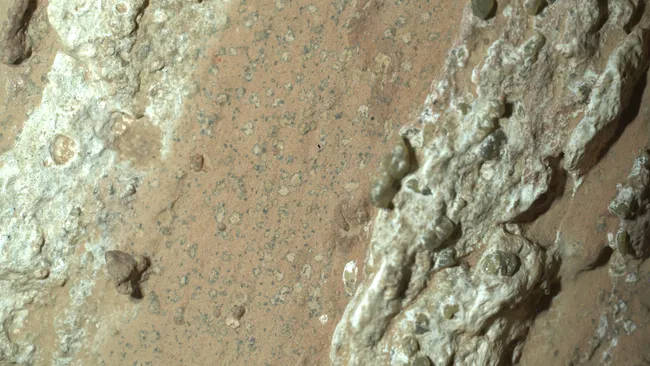NASA’s Perseverance rover may have found traces of ancient life in a rock on Mars; scientists on the mission team are excited but cautious because more analysis is needed to confirm the discovery.
The rover came across an intriguing arrowhead-shaped rock that contained chemical signatures and structures that could have been formed by microbial life billions of years ago, when Mars was much wetter than it is today. Inside the rock, which scientists have dubbed “Cheyawa Falls,” Perseverance’s instruments revealed organic compounds that were precursors to the chemistry of life as we know it. The entire length of the rock is crossed by veins of calcium sulfate, mineral deposits that indicate that the water necessary for life once flowed through the rock.
The rover also discovered dozens of millimeter-sized spots, each surrounded by a black ring that mimics the appearance of leopard spots. These rings contain iron and phosphates that can be seen on Earth as a result of chemical reactions caused by microbes.
“These spots are a big surprise,” said David Flannery, an astrobiologist at the Queensland University of Technology in Australia and member of the Perseverance science team.
“On Earth, such features in rocks are often associated with the fossil record of deep-dwelling microbes.”
“We’ve never seen these three things together on Mars before,” Perseverance scientist Morgan Cable said in a video NASA released on YouTube today (July 25).
Cheyava Falls lies on the edge of a 400-meter (437-yard) wide ancient river valley called the Neretva Valley. Scientists suspect that this ancient channel was cut long ago by water gushing into the lake crater; the Neretva Valley runs along the inner wall of this area. In one possible scenario, mud already containing organic compounds poured into the valley and then cemented itself into the bedrock of Cheyawa Falls, which was sampled by Perseverance on July 21. The second part of the water escaping into the formed rock may have created the object’s calcium-sulfate veins and black-ringed spots the team sees today.
To be clear, the visible rock features are not definitive evidence of ancient microbial life on Mars—at least not yet. For example, it’s possible that the calcium sulfate observed was introduced into the rock at temperatures inhospitable to life, perhaps during a nearby volcanic event. But whether such nonbiological chemical reactions led to the observed black dots is an open question, the scientists say.
“This trip to the Neretva Valley bed paid off because we found something we’ve never seen before that will give our scientists a lot to work with,” Nicola Fox, associate administrator for NASA’s Science Mission Directorate, said in a statement.
“We captured this rock with lasers and X-rays and photographed it literally day and night from almost every conceivable angle,” Ken Farley, Perseverance project scientist at Caltech, said in a statement. “Scientifically, Perseverance has nothing else to offer.”
To fully understand what really happened in the ancient river valley billions of years ago, scientists aim to bring a sample of Cheyawa Falls back to Earth, where it can be carefully examined with powerful instruments not included in Perseverance’s limited kit.
But the comprehensive effort to return samples from Mars has hit several snags in recent months after costs soared to $11 billion. As it stands, the program requires multiple Mars launches to land a rover on the Red Planet, after which Perseverance would either return to the rover and drop off the collected samples or transfer them to a search helicopter that could complete the study. Hands off Ascension would then launch the samples into orbit, where the spacecraft would collect them and return them to Earth.
NASA considered a variety of simpler alternatives from industry and academic groups and awarded $1.5 million in contracts to seven companies researching the topic; three of the agency’s in-house research centers are also conducting research.













